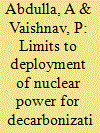| Srl | Item |
| 1 |
ID:
151176


|
|
|
|
|
| Summary/Abstract |
The performance of International Relations (IR) scholarship – as in all scholarship – acts to close and police the boundaries of the discipline in ways that reflect power–knowledge relations. This has led to the development of two strands of work in ontological security studies in IR, which divide on questions of ontological choice and the nature of the deployment of the concept of dread. Neither strand is intellectually superior to the other and both are internally heterogeneous. That there are two strands, however, is the product of the performance of IR scholarship, and the two strands themselves perform distinct roles. One allows ontological security studies to engage with the ‘mainstream’ in IR; the other allows ‘international’ elements of ontological security to engage with the social sciences more generally. Ironically, both can be read as symptoms of the discipline’s issues with its own ontological (in)security. We reflect on these intellectual dynamics and their implications and prompt a new departure by connecting ontological security studies in IR with the emerging interdisciplinary fields of the ‘vernacular’ and ‘everyday’ via the mutual interest in biographical narratives of the self and the work that they do politically.
|
|
|
|
|
|
|
|
|
|
|
|
|
|
|
|
| 2 |
ID:
166518


|
|
|
|
|
| Summary/Abstract |
Decarbonization will require deployment of low-carbon technologies, but analysts have struggled to quantify which ones could be deployed in practice—especially where technologies have faced public opposition. For nuclear power, some analysts have tried to solve this problem with caps on deployment or nuclear-free scenarios; however, social science research has not offered nuanced guidance about these caps. We deploy an experiment involving a large U.S. sample (N = 1226) to disentangle public opposition due to the dread of nuclear power from opposition stemming from its actuarial risk. Respondents are asked to build a power generation portfolio that cuts CO2 emissions, given information about the actuarial risks of technologies. Half the sample is exposed to the nuclear power label while the other half is treated with the risk information but blinded to the label. Respondents who see the labels deploy 6.6 percentage points less nuclear power as a share of the U.S. electricity mix. Our results suggest that dread about nuclear power leads respondents to choose 40% less nuclear generation in 2050 than they would have chosen in the absence of this dread. These methods could apply to other technologies, such as carbon storage, where there may be gaps between actuarial and perceived risks.
|
|
|
|
|
|
|
|
|
|
|
|
|
|
|
|